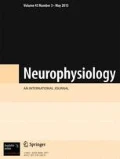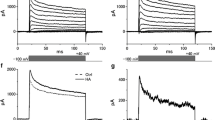Abstract
The effect of electrical stimulation of the optic nerve on various cells in the frog's retina was investigated by two methods: by the histochemical method (measurement of the amount of RNA in separate cells), and by intracellular recording of potentials. Rhythmic (5 per sec) stimulation of the nerve induced an increase in the amount of RNA in ganglion cells, and especially in amacrine cells. The level of RNA in bipolar and horizontal cells did not change. The results of the experiment indicate that in frogs (as in birds) centrifugal effects are produced through amacrine cells. In electrophysiological experiments reactions to stimulation of the nerve were manifested only in ganglion and amacrine cells. In the ganglion cells that was an antidromic impulse, but sometimes also a delayed impulse, which was evidently the result of secondary excitation of the cell. In amacrine cells the response consisted of a short excitant postsynaptic potential with a discharge of impulses superimposed on it. Data are presented indicating the existence of amacrine cells of different types, probably fulfilling different functions.
Similar content being viewed by others
Literature cited
V. Ya. Brodskii, Cell Nutrition [in Russian], Nauka (1966).
A. L. Byzov, "Analysis of distribution of potentials and currents within the retina on light stimulation. I. Activity of bipolar cells of two types," Biofizika,4, 689–701 (1959).
A. L. Byzov, Electrophysiological Investigation of the Retina [in Russian], Nauka (1966).
A. L. Byzov, N. A. Polishchuk, and G. M. Zenkin, "Impulse and nonimpulse transmission of signals in the vertebrate retina," Neirofiziologiya,2, 536–543 (1970).
G. M. Zenkin, V. V. Maksimov, and A. L. Byzov, "Investigation of horizontal interaction at the level of slow bipolar cells in the frog's retina. I. Effect of diffuse light and some features of interaction," Biofizika,9, 612–620 (1964).
A. V. Minor, G. I. Flerova, and A. L. Byzov, "Total evoked potentials and activity of solitary neurons in the olfactory bulb of the frog," Neirofiziologiya,1, 269–277 (1969).
M. A. Ostrovskii, "Descending effects on the retina of the frog's eye," Biofizika,7, 55–63 (1962).
I. A. Utina, "Investigation of the activity of bipolar cells of two types by the UV cytophotometric method," Biofizika,5, 626–630 (1960).
I. A. Utina, "Changes in RNA content in horizontal and amacrine cells in the frog's retina in different lighting conditions," Dokl. Akad. Nauk SSSR,157, 1216–1218 (1964).
N. Abe, "Effect of section and compression of the optic nerve on the ERG in the rabbit," Tohoku J. Exptl. Med.,78, 223–227 (1962).
G. S. Brindley and D. J. Hamasaki, "Evidence that the cat's electroretinogram is not influenced by impulses passing to the eye along the optic nerve," J. Physiol. (Eng.),163, 558–565 (1962).
W. M. Cowan, "Centrifugal fibres to the avian retina," Brit. Med. Bull.,26, 112–118 (1970).
A. S. Dogiel, "Die Retina der Vögel," Arch. mikr. Anat.,44, 622–648 (1895).
J. E. Dowling, "Synaptic organization of the frog retina: an electron microscopic analysis comparing the retinas of frog and primates," Proc. Roy. Soc., B,170, 205–228 (1968).
J. E. Dowling and W. M. Cowan, "An electron microscope study of normal and degenerating centrifugal fiber terminals in the pigeon retina," Z. Zellforsch.,71, 14–28 (1966).
J. C. Eccles, Physiology of Nerve Cells, Baltimore (1957).
B. Ehinger, B. Falck, and A. M. Laties, "Adrenergic neurons in Teleost retina," Z. Zellforsch. und microsc. Anat.,97, 285–297 (1969).
R. Granit, Sensory Mechanisms of the Retina, Oxford (1947).
J. H. Jacobson and G. F. Gestring, "Centrifugal influence upon the electroretinogram," Arch. Ophthalmol.,60, 295–302 (1958).
A. Kaneko, "Physiological and morphological identification of horizontal, bipolar, and amacrine cells in goldfish retina," J. Physiol. (Engl.),207, 623–633 (1970).
T. E. Ogden and K. T. Brown, "Intraretinal responses of the cynamolgus monkey to electrical stimulation of the optic nerve and retina," J. Neurophysiol.,27, 682–705 (1964).
S. L. Polyak, The Retina, Chicago (1941).
S. Ramon y Cajal, Die Retina der Wirbelthiere, Wiesbaden (1894).
K. Tasaki, A. C. Norton, and J. Fukada, "Effect of optic nerve stimulation on the intraretinal ERG of the cat," Tohoku J. Exptl. Med.,78, 142–146 (1962).
F. S. Werblin and J. E. Dowling, "Organization of the retina of the mudpuppy,Necturus maculosus. 11. Intracellular recording," J. Neurophysiol.,32, 339–355 (1969).
Additional information
Institute of Information Transmission, Academy of Sciences of the USSR, Moscow. Translated from Neirofiziologiya, Vol. 3, No. 3, pp. 293–300, May–June, 1971.
Rights and permissions
About this article
Cite this article
Byzov, A.L., Utina, I.A. Centrifugal effects on amacrine cells in the frog's retina. Neurophysiology 3, 219–224 (1971). https://doi.org/10.1007/BF01065496
Received:
Issue Date:
DOI: https://doi.org/10.1007/BF01065496




